The Skylake Core i3 (51W) CPU Review: i3-6320, i3-6300 and i3-6100 Tested
by Ian Cutress on August 8, 2016 9:00 AM ESTLegacy Benchmarks
Some of our legacy benchmarks have followed AnandTech for over a decade, showing how performance changes when the code bases stay the same in that period. Some of this software is still in common use today.
All of our benchmark results can also be found in our benchmark engine, Bench.
3D Particle Movement v1
3DPM is a self-penned benchmark, taking basic 3D movement algorithms used in Brownian Motion simulations and testing them for speed. High floating point performance, MHz and IPC wins in the single thread version, whereas the multithread version has to handle the threads and loves more cores. This is the original version, written in the style of a typical non-computer science student coding up an algorithm for their theoretical problem, and comes without any non-obvious optimizations not already performed by the compiler, such as false sharing.

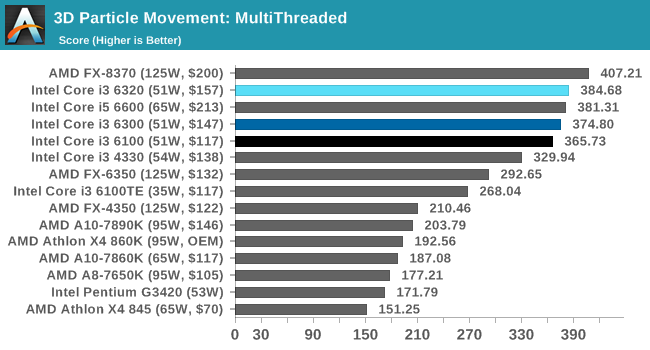
With un-trained programming skills comes a myriad of results. 3DPMv1 is not cache bound, but highly affected by false sharing and IPC. Our Core i3 staircase is in effect, and AMD is badly affected requiring 8 threads to match/beat an i3. In our v2 results, the spread is a more believable, which goes to show that having the right programming paradigm (even just a couple of lines of code) can make a large difference.
CineBench 11.5 and 10
Cinebench is a widely known benchmarking tool for measuring performance relative to MAXON's animation software Cinema 4D. Cinebench has been optimized over a decade and focuses on purely CPU horsepower, meaning if there is a discrepancy in pure throughput characteristics, Cinebench is likely to show that discrepancy. Arguably other software doesn't make use of all the tools available, so the real world relevance might purely be academic, but given our large database of data for Cinebench it seems difficult to ignore a small five minute test. We run the modern version 15 in this test, as well as the older 11.5 and 10 due to our back data.
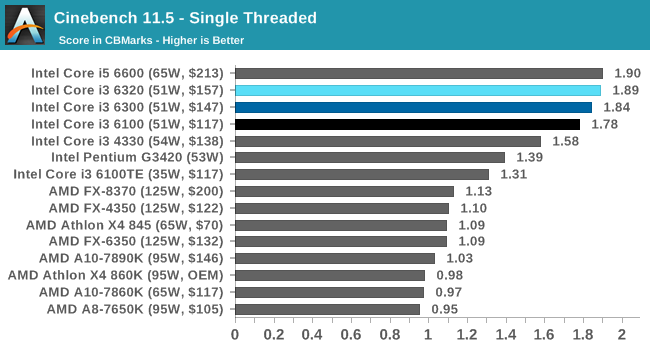
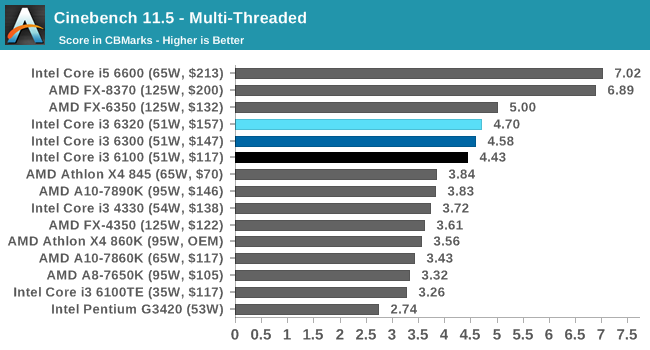
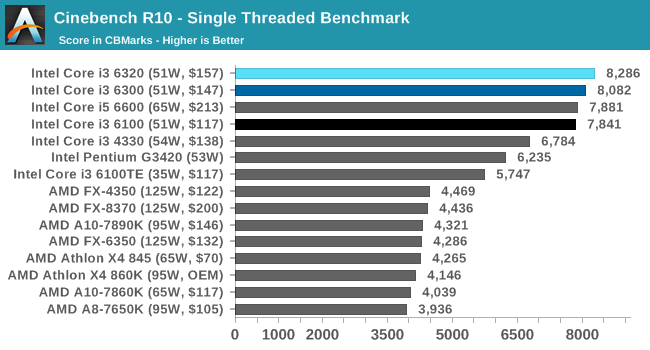

The older CB results mirror the CB15 test, albeit more compressed.
POV-Ray 3.7
POV-Ray is a common ray-tracing tool used to generate realistic looking scenes. We've used POV-Ray in its various guises over the years as a good benchmark for performance, as well as a tool on the march to ray-tracing limited immersive environments. We use the built-in multithreaded benchmark.
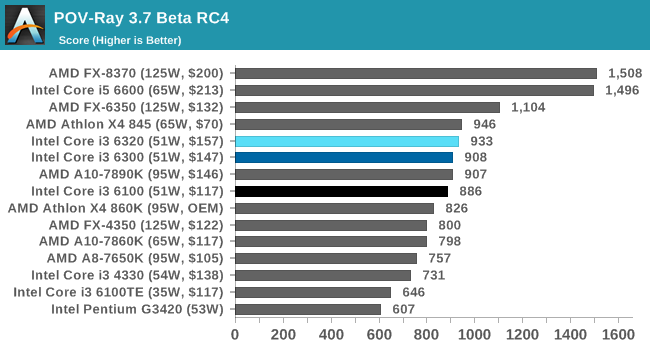
AMD gets a better showing in POV-Ray, with the $70 X4 845 going ahead of all of our Core i3 parts, and the older A10 sitting in between them. The older FX parts, despite their age, take advantage of the multi-threaded nature of the benchmark.
TrueCrypt 7.1
Before its discontinuation, TrueCrypt was a popular tool for WindowsXP to offer software encryption to a file system. The almost latest version, 7.1, is still widely used however the developers have stopped supporting it since the introduction of encrypted disk support in Windows 8/7/Vista from 5/2014, and as such any new security issues are unfixed.
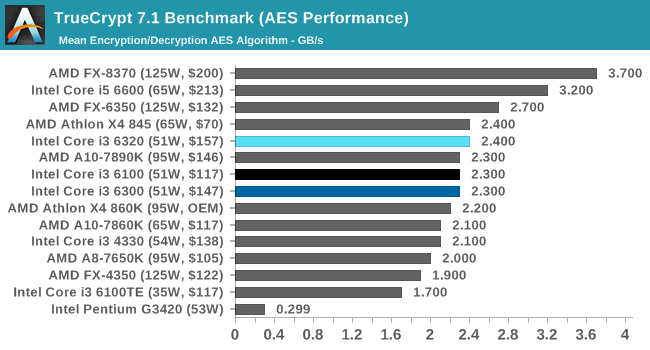
x264 HD 3.0
Similarly, the x264 HD 3.0 package we use here is also kept for historic regressional data. The latest version is 5.0.1, and encodes a 1080p video clip into a high quality x264 file. Version 3.0 only performs the same test on a 720p file, and in most circumstances the software performance hits its limit on high end processors, but still works well for mainstream and low-end. Also, this version only takes a few minutes, whereas the latest can take over 90 minutes to run.
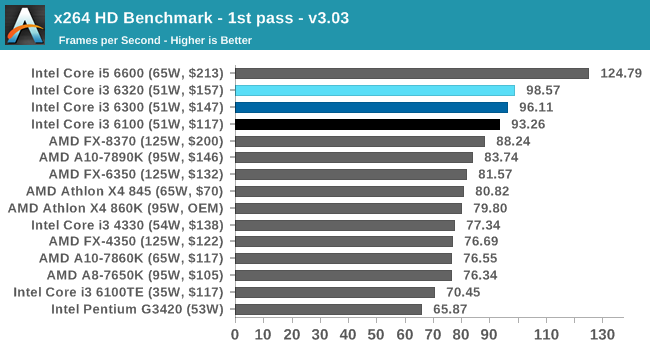
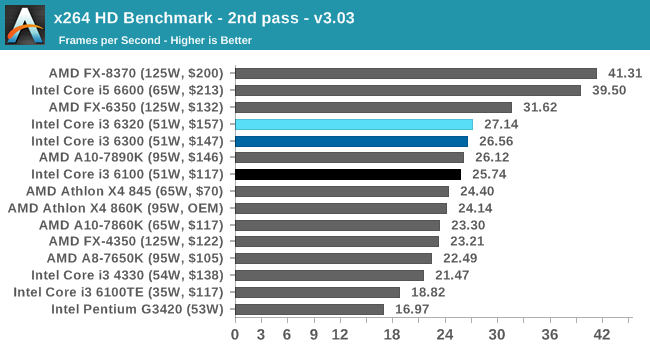
7-zip
7-Zip is a freeware compression/decompression tool that is widely deployed across the world. We run the included benchmark tool using a 50MB library and take the average of a set of fixed-time results.
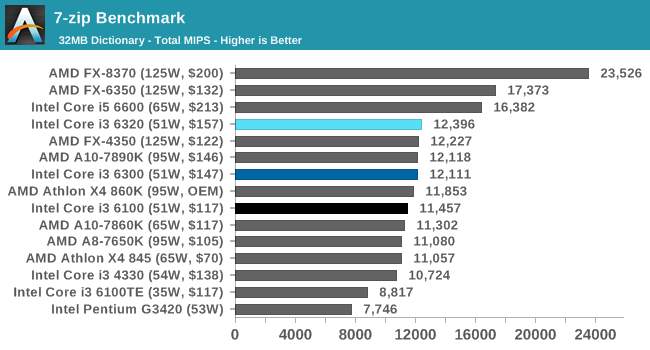










94 Comments
View All Comments
jabber - Tuesday, August 9, 2016 - link
Yeah, unfortunately, a lot of IT guys assume that because they run quad cores at 100% all day long with 32GB of ram that Helen on the front desk or Mike in Sales needs the same. They don't. Similar to Ratman I sell a lot of recon Dell and HP ex corporate machines to my small business customers. 2010 spec machines with dual core 3GHz Pentiums with 4-8GB of ram. They can buy three of them for the cost of a 2016 model. They love them. If they need a real boost, a 120GB SSD gets slapped in. They pee their pants with excitement when that happens. Standard business computing was finally catered for many many years ago. It hasn't really changed.BrokenCrayons - Tuesday, August 9, 2016 - link
Decrepit Core 2 Duos are indeed perfectly acceptable for poking around on the internet and handling basic office workloads. I'm fairly happy using a T2310-based laptop (C2D@1.46GHz) with 2GB of RAM and a recently purchased 500GB 5400 RPM drive for most of my day-to-day computing tasks. I can feel the system's performance catching up when I ask the Intel x3100 graphics card to chug through anything higher than 720p video on Youtube. Most of my gaming is streamed through Steam so the box on the user end isn't as important as the computer that actually runs the game with reduces my concern pretty significantly when it comes to keeping my laptop up-to-date. I'm pretty sure I can squeeze another year or two out of it before handing it over to the electronics recycling center.Like jabber says, office work has long since been addressed by technological advancements and _most_ home computing needs aside from throwing around modern games have too.
Icehawk - Tuesday, August 9, 2016 - link
We have some C2Ds at work, and yeah for a regular office job they are fine IF they have 8gb of RAM, unfortunately these machines are so old keeping them running or upgrading is a hassle. And at least here, unless you are in IT or a programmer good luck getting a SSD. A newer i3 with 8gb and SSD is definitely enough for any casual user at work or home for sure.BrokenCrayons - Wednesday, August 10, 2016 - link
It depends a lot on the workload. 2GB is sufficient for almost everything I do on a home computer except for the occasional game. In an office setting 4-8GB would be better just because workforce users tend to leave a larger number of programs open at once. I do agree that in a workplace, computers should still be replaced every 3-5 years due to upgrade and maintenance issues that crop up as they age past that point even if the system performance is still perfectly adequate.lilmoe - Monday, August 8, 2016 - link
Do tell how to spread a select query (with a join or two) on multiple equally tasked threads when you only need to query a huge table (with the others being relatively tiny).i3s are my go-to recommendation for clients needing POS stations and others that only need a client/terminal for an ERP database.
lilmoe - Monday, August 8, 2016 - link
What's being multithreaded is the UI, almost exclusively. And that's for responsiveness rather than speed, in which 2 cores more than suffice.elbert - Monday, August 8, 2016 - link
Thats not how it works. This is like arguing against dual cores because there was no threaded software. Chicken and the egg is a fun game but the process has to come first.bug77 - Tuesday, August 9, 2016 - link
There's no chicken and egg here. We've had 8 thread capable CPUs for years. But we simply don't need them at home or for typical desktop usage.They're great for 3D rendering, video editing or programming, but they're not for everyone.
elbert - Tuesday, August 9, 2016 - link
Dual cores aren't for everyone so lets just agree they should moved to a tablet or watch. Intel needs to move on 6 core Kaby Lake for the main steam at the very least.bug77 - Wednesday, August 10, 2016 - link
No, we don't agree on that. Dual core is plenty for typical web browsing and occasionally writing a paper for school. I'm on an i5 for years and I rarely see all 4 cores put to use at the same time.You're entitled to your opinion, of course, but I don't agree with it.